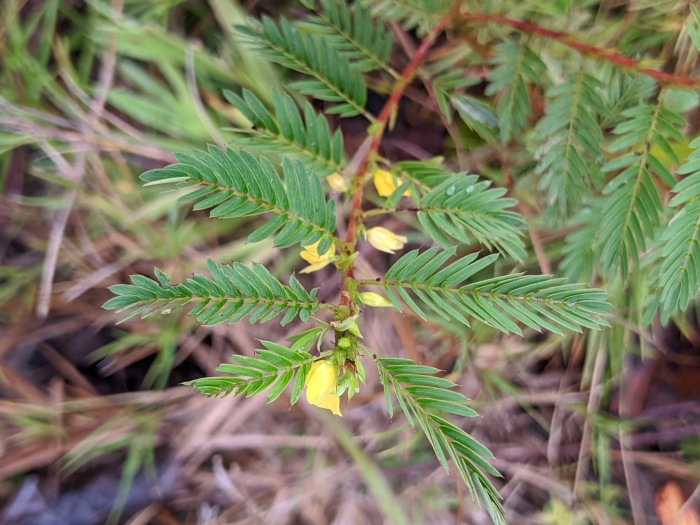Sensitive Partridge Pea
(Chamaecrista nictitans)
Sensitive Partridge Pea (Chamaecrista nictitans)
/
/

Scott Allen Davis
CC BY 4.0
Image By:
Scott Allen Davis
Recorded By:
Copyright:
CC BY 4.0
Copyright Notice:
Photo by: Scott Allen Davis | License Type: CC BY 4.0 | License URL: http://creativecommons.org/licenses/by/4.0/ | Rights Holder: Scott Allen Davis | Publisher: iNaturalist | Date Created: 2020-09-24T13:58-07:00 |




















































Estimated Native Range
Summary
Chamaecrista nictitans, commonly known as Sensitive Partridge Pea, is an annual herb or occasional subshrub native to a variety of habitats including open woodlands, grasslands, roadsides, and disturbed areas throughout the Eastern and Southern United States, as well as the Caribbean, Mexico, Central, and South America. It typically grows to a height of 1 foot (0.3 meters) and a width of 1-2 feet (0.3-0.6 meters). The plant features pinnate leaves with small, sensitive leaflets that fold together when touched, a characteristic that has fascinated many. During the summer months, it produces showy yellow flowers with five petals, each adorned with purple or red spots at the base, attracting pollinators such as bees and butterflies.
Sensitive Partridge Pea is valued for its nitrogen-fixing ability, which can improve soil fertility, and its adaptability to poor soils, making it useful for soil stabilization and restoration projects. It is also appreciated for its ornamental flowers and interesting leaf movements. In cultivation, it thrives in full sun and requires low amounts of water, preferring well-drained soils. While it is not typically used as forage or hay due to its potential toxicity to livestock, it can be utilized for these purposes in subtropical areas where other options are limited. Gardeners should note that it can self-seed prolifically and may become weedy if not managed properly.CC BY-SA 4.0
Sensitive Partridge Pea is valued for its nitrogen-fixing ability, which can improve soil fertility, and its adaptability to poor soils, making it useful for soil stabilization and restoration projects. It is also appreciated for its ornamental flowers and interesting leaf movements. In cultivation, it thrives in full sun and requires low amounts of water, preferring well-drained soils. While it is not typically used as forage or hay due to its potential toxicity to livestock, it can be utilized for these purposes in subtropical areas where other options are limited. Gardeners should note that it can self-seed prolifically and may become weedy if not managed properly.CC BY-SA 4.0
Plant Description
- Plant Type: Herb
- Height: 0.5-1.5 feet
- Width: 1-1.5 feet
- Growth Rate: Moderate
- Flower Color: Yellow
- Flowering Season: Summer
- Leaf Retention:
Growth Requirements
- Sun: Full Sun
- Water: Low
- Drainage: Fast
Common Uses
Bee Garden, Bird Garden, Butterfly Garden, Drought Tolerant, Low Maintenance
Natural Habitat
Open woodlands, grasslands, roadsides, and disturbed areas
Other Names
Common Names: Sensitive Plant , Sensitive-Pea , Sensitive Cassia , Sensitive Partridge-Pea , Wild Sensitive-Plant , Partridge Pea , Partridge-Pea
Scientific Names: Chamaecrista nictitans , Chamaecrista nictitans subsp. nictitans , Cassia nictitans , Cassia mimosoides , Chamaecrista millspaughii , Cassia nictidans , Cassia nictitans var. conmixta , Chamaecrista multipinnata , Chamaecrista nictitans var. conmixta
GBIF Accepted Name: Chamaecrista nictitans (L.) Moench